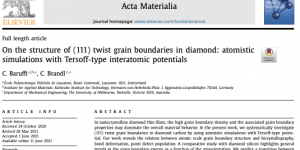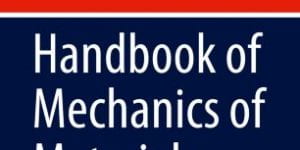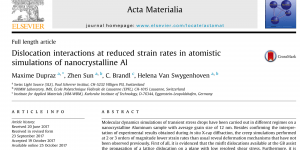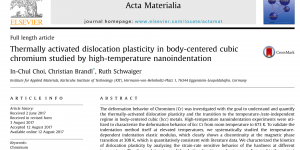 https://doi.org/10.1016/j.actamat.2021.117055 Abstract: In nanocrystalline diamond thin films, the high grain boundary density and the associated grain boundary properties may dominate the overall material behavior. In the present work, we systematically investigate (111) twist grain boundaries in diamond carbon by using atomistic simulations with Tersoff-type potential. Our work reveals the relation between atomic scale grain boundary […]
https://doi.org/10.1016/j.actamat.2021.117055 Abstract: In nanocrystalline diamond thin films, the high grain boundary density and the associated grain boundary properties may dominate the overall material behavior. In the present work, we systematically investigate (111) twist grain boundaries in diamond carbon by using atomistic simulations with Tersoff-type potential. Our work reveals the relation between atomic scale grain boundary […]
blogs.unimelb.edu.au/materials-mechanics-modelling/2021/03/22/on-the-structure-of-111-twist-grain-boundaries-in-diamond-atomistic-simulations-with-tersoff-type-interatomic-potentials
 http://link.springer.com/10.1007/978-981-10-6855-3_12-1 Abstract: Nanopolycrystals are polycrystalline metals with an average grain size below 100 nm and exhibit extraordinary strength values. In contrast to the coarse-grained polycrystals, the confinement by grain boundaries of the plastic deformation in the grains approaches limits, where the conventional theories break down. In the grain size regime 10–20 nm, molecular dynamics simulations play a […]
http://link.springer.com/10.1007/978-981-10-6855-3_12-1 Abstract: Nanopolycrystals are polycrystalline metals with an average grain size below 100 nm and exhibit extraordinary strength values. In contrast to the coarse-grained polycrystals, the confinement by grain boundaries of the plastic deformation in the grains approaches limits, where the conventional theories break down. In the grain size regime 10–20 nm, molecular dynamics simulations play a […]
blogs.unimelb.edu.au/materials-mechanics-modelling/2019/10/22/molecular-dynamics-simulations-of-nanopolycrystals
 https://linkinghub.elsevier.com/retrieve/pii/S1359645417309023 Abstract: Molecular dynamics simulations of transient stress drops have been carried out in different regimes on a nanocrystalline Aluminum sample with average grain size of 12 nm. Besides confirming the interpretation of experimental results obtained during in situ X-ray diffraction, the creep simulations performed at 2 or 3 orders of magnitude lower strain rates […]
https://linkinghub.elsevier.com/retrieve/pii/S1359645417309023 Abstract: Molecular dynamics simulations of transient stress drops have been carried out in different regimes on a nanocrystalline Aluminum sample with average grain size of 12 nm. Besides confirming the interpretation of experimental results obtained during in situ X-ray diffraction, the creep simulations performed at 2 or 3 orders of magnitude lower strain rates […]
blogs.unimelb.edu.au/materials-mechanics-modelling/2018/10/22/dislocation-interactions-at-reduced-strain-rates-in-atomistic-simulations-of-nanocrystalline-al
 http://www.sciencedirect.com/science/article/pii/S1359645417306808 The deformation behavior of Chromium (Cr) was investigated with the goal to understand and quantify the thermally-activated dislocation plasticity and the transition to the temperature-/rate-independent regime in body-centered cubic (bcc) metals. High-temperature nanoindentation experiments were utilized to characterize the deformation behavior of bcc Cr from room temperature to 673 K. To validate the indentation method itself at elevated temperatures, we systematically […]
http://www.sciencedirect.com/science/article/pii/S1359645417306808 The deformation behavior of Chromium (Cr) was investigated with the goal to understand and quantify the thermally-activated dislocation plasticity and the transition to the temperature-/rate-independent regime in body-centered cubic (bcc) metals. High-temperature nanoindentation experiments were utilized to characterize the deformation behavior of bcc Cr from room temperature to 673 K. To validate the indentation method itself at elevated temperatures, we systematically […]
blogs.unimelb.edu.au/materials-mechanics-modelling/2017/10/22/thermally-activated-dislocation-plasticity-in-body-centered-cubic-chromium-studied-by-high-temperature-nanoindentation
 https://onlinelibrary.wiley.com/doi/10.1002/advs.201700159 Abstract: Some metal alloys subjected to irreversible plastic deformation can repair the inflicted damage and/or recover their original shape upon heating. The conventional shape memory effect in metallic alloys relies on collective, or “military” phase transformations. This work demonstrates a new and fundamentally different type of self-healing and shape memory in single crystalline faceted […]
https://onlinelibrary.wiley.com/doi/10.1002/advs.201700159 Abstract: Some metal alloys subjected to irreversible plastic deformation can repair the inflicted damage and/or recover their original shape upon heating. The conventional shape memory effect in metallic alloys relies on collective, or “military” phase transformations. This work demonstrates a new and fundamentally different type of self-healing and shape memory in single crystalline faceted […]
blogs.unimelb.edu.au/materials-mechanics-modelling/2017/10/22/self-healing-and-shape-memory-effects-in-gold-microparticles-through-the-defects-mediated-diffusion




